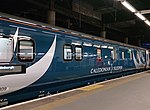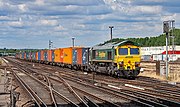The British Rail Mark 4 is a class of passenger carriages built for use in InterCity 225 sets on the East Coast Main Line between King's Cross, Leeds...
17 KB (1,789 words) - 23:50, 16 June 2024
Mark 2 family of railway carriages are British Rail's second design of carriages. They were built by British Rail workshops (from 1969 British Rail Engineering...
23 KB (2,426 words) - 05:06, 8 August 2024
The British Rail Mark 3 is a type of passenger carriage developed in response to growing competition from airlines and the car in the 1970s. A variant...
41 KB (4,531 words) - 21:30, 23 August 2024
British Rail Mark 1 is the family designation for the first standardised designs of railway carriages built by British Railways (BR) from 1951 until 1974...
32 KB (4,046 words) - 16:12, 17 August 2024
service from Dublin to Cork. These carriages have no connection to the British Rail Mark 4. Along with the occasional Cravens stocked train[further explanation...
8 KB (863 words) - 13:34, 16 September 2024
The British Rail Mark 5A is a type of railway vehicle in use in the UK. 52 standard carriages and 14 driving trailers were built by Spanish manufacturer...
12 KB (907 words) - 08:30, 22 September 2024
The British Rail Mark 5 is the designation given to locomotive-hauled rail carriages built by Spanish manufacturer CAF for operation with Caledonian Sleeper...
10 KB (951 words) - 15:08, 21 April 2024
British Rail Engineering Limited (BREL) was the rolling stock manufacturing and maintenance subsidiary of British Rail. It was established on 1 January...
19 KB (1,647 words) - 10:35, 16 August 2024
British Rail Class 37 is a diesel-electric locomotive. Also known as the English Electric Type 3, the class was ordered as part of the British Rail modernisation...
85 KB (8,599 words) - 18:05, 6 September 2024
unveil our latest class 66 newly renamed 'British Rail 1948-1997'. The loco marks the 70th anniversary of British Railways and is currently undergoing a...
90 KB (6,877 words) - 14:31, 2 October 2024
During the 2000s, the British train operating company Direct Rail Services (DRS) recognised that its small fleet of British Rail Class 20 diesel locomotives...
33 KB (2,696 words) - 12:04, 8 October 2024
The British Rail Class 323 is a class of electric multiple unit (EMU) passenger train built by Hunslet Transportation Projects and Holec. All 43 units...
35 KB (2,975 words) - 20:53, 7 October 2024
the British Mark I tank, 1917 Bristol Blenheim Mk.IV, light bomber in Royal Air Force service before and during World War II British Rail Mark 4, passenger...
3 KB (409 words) - 23:34, 16 May 2024
introduced by British Rail in 1966 for its long-haul express passenger services (see British Rail brand names for a full history). In 1982, the British Railways...
33 KB (3,270 words) - 13:29, 9 September 2024
The British Rail Mark 5 is the designation given to the planned passenger rolling stock for the InterCity 250 project, a plan to improve speeds on the...
10 KB (1,236 words) - 11:18, 20 May 2023
The British Rail Class 411 (4CEP) electric multiple units were built at Eastleigh works from 1956–63 for the newly electrified main lines in Kent. These...
33 KB (2,855 words) - 05:55, 26 August 2024
the prototype High Speed Train (HST) with Mark 3 carriages. Two power cars were built in 1972 by British Rail Engineering Limited's Crewe Works, numbered...
9 KB (739 words) - 11:44, 17 January 2024
Great Britain British electric multiple units British railcars and diesel multiple units History by era History of rail transport in Great Britain to 1830...
62 KB (6,298 words) - 04:19, 16 August 2024
The British Rail Class 90 is a type of electric locomotive. They were built for mixed-traffic duties, operating from 25 kV AC overhead lines and producing...
41 KB (3,436 words) - 15:04, 5 October 2024
The privatisation of British Rail was the process by which ownership and operation of the railways of Great Britain passed from government control into...
57 KB (5,760 words) - 01:32, 25 July 2024
1985–87. They were the first of several classes of British Rail EMU to be based on the all-steel Mark 3 bodyshell, departing from the PEP-aluminium design...
41 KB (3,835 words) - 00:49, 6 October 2024
Great British Railways (GBR) is a planned state-owned company that is to oversee rail transport in Great Britain except for Transport for London, Merseytravel...
19 KB (1,742 words) - 08:52, 3 October 2024
electrification of the East Coast Main Line was under way, British Rail realised that the new Mark 4 carriages for the Class 89 and Class 91 locomotives were...
65 KB (6,057 words) - 20:58, 20 September 2024
British Railways (BR), which from 1965 traded as British Rail, was a state-owned company that operated most rail transport in Great Britain from 1948...
103 KB (10,123 words) - 07:29, 20 September 2024
InterCity 125 (redirect from British Rail class 253)
eight Mark 3 coaches. The name is derived from its top operational speed of 125 mph (201 km/h). At times, the sets have been classified as British Rail Classes...
93 KB (9,869 words) - 11:40, 7 October 2024
Wealdstone Station in the London Midland Region, British Railways (PDF). Ministry of Transport, Rail Accident Investigation Branch. p. 1. Currie 1971...
157 KB (6,799 words) - 22:46, 3 October 2024
The British Rail Class 150 Sprinter is a class of diesel-hydraulic multiple unit passenger trains, developed and built by British Rail Engineering Limited...
60 KB (5,761 words) - 01:15, 6 October 2024
The British Rail Class 897 is a type of tri-mode electro-diesel multiple unit to be manufactured by CAF for London North Eastern Railway. Ten ten-car units...
5 KB (394 words) - 17:17, 5 October 2024
versions of British Rail's BT22 Air Suspension bogie, and were air-braked. The Irish Mark 3 coaches were similar, but not identical, to their British counterparts...
61 KB (6,195 words) - 17:23, 5 August 2024
constructed with the British Rail Mark 2 bodyshell, as well as the last class of multiple unit to be built with slam doors in Britain. These features contributed...
17 KB (1,178 words) - 00:55, 24 August 2024























